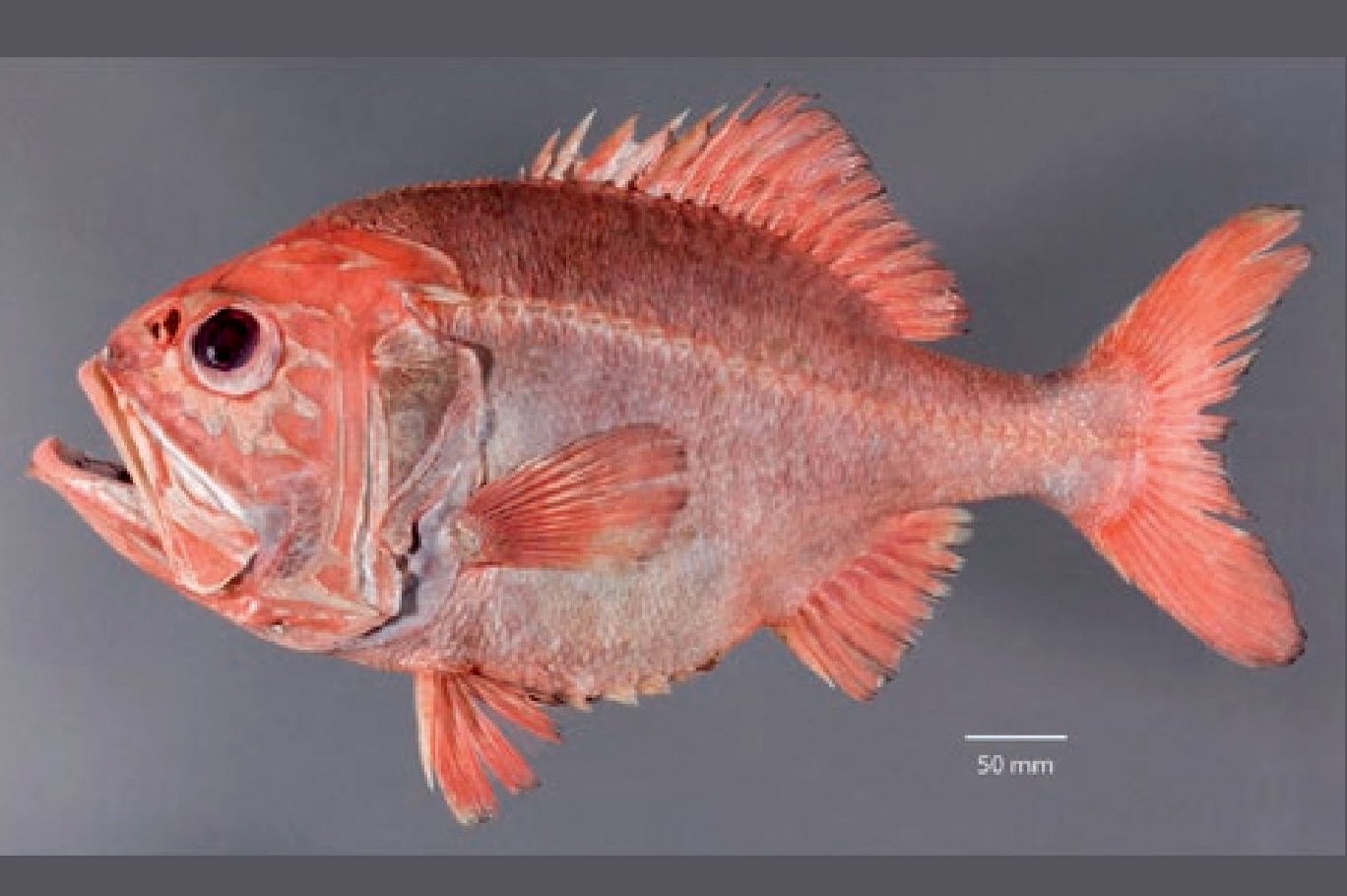Hoplostethus melanopeza Roberts & Gomon 2012

A paratype of Hoplostethus melanopeza (NMNZ P.053308, 486 mm SL), from east of Mayor Island, Bay of Plenty, North Island, New Zealand, depth 540 m, March 2012. Source: Carl Struthers / Museum of New Zealand, Te Papa Tongarewa. License: All rights reserved
Identifying features:
• Head and body overall dark greyish-red
• Top side of tongue, gill arches and gill cavities black
• Front of mouth including underside of tongue mostly white
• Fins deep red with distinct black margins
Hoplostethus melanopeza Roberts & Gomon 2012
More Info
|
Distribution |
Sub–tropical and temperate waters of the Tasman and South Fiji Basins in the south–western Pacific, between about 33° and 37°S, from the continental slope off south–eastern Australian on the west, to the outer Bay of Plenty and southern Kermadec Ridge at the north end of the North Island in New Zealand in the east. H. melanopeza occurs on continental slopes, seamounts and submarine rises in depths of 140–760 m, mostly at 250–400 m. |
|
Features |
Meristic features: Body ovoid, deep, depth 1.9–2.1 in SL; nape gently curved, forehead almost straight to above upper lip. Dorsal– and anal–fin spines of moderate thickness. Scales absent from isthmus; body scales adherent; lateral–line scales with strong medial ridge, but no spine in small and medium sized adults, with strong spine centrally on posterior margin in large adults; scales on predorsal midline forming low raised ridge. |
|
Size |
Reaches at least 515 mm SL. |
|
Colour |
Fresh specimens: head and body dark greyish red; opercle dark greyish-red; dark areas of buccal and branchial cavities black; vomer, margins of mouth roof lateral to palatines, underside of tongue and upper surface of lower jaw stark white; fins a deep red with narrow black margins in adults. In preservative: grey (juveniles pale below a line between humeral spine and dorsal side of caudal peduncle near termination of dorsal fin base, dusky above); opercle dark; buccal and branchial chambers dark, including gill arches and rakers; vomer, roof of mouth lateral to palatines, underside of tongue and lower jaw uniformly pale; fins pale with narrow dark margins (juveniles with pale fins, except for slightly dusky outer portion of membrane between dorsal–fin spines). |
|
Biology |
Although nothing is known of the biology of this species, like other deepwater roughies, H. melanopeza is likely to take many years to mature and be very long-lived. |
|
Conservation |
|
|
Similar Species |
Hoplostethus melanopeza is very similar to H. gigas, with which it has been confused in the past. Although both species have a similar overall red or reddish–orange colouration, large individuals of H. melanopeza have distinct black margins to all fins, while the edges of only the medial fins appear to be no more than dark grey to blackish in large individuals of H. gigas. H. melanopeza also has a greater number of predorsal scales (16–22 versus. 9–15) and a higher mean value for total gill rakers of 19.7 versus 18.0, based on material examined. At comparable sizes H. melanopeza has a slightly deeper body and shorter pelvic to anal–fin length than H. gigas, although additional material of various size ranges is needed for a full comparison. |
|
Etymology |
The species name melanopeza is from the Greek melano meaning ‘black’ and peza meaning ‘edge’, in reference to the characteristic black edge on all fins in large individuals of this species. |
|
Species Citation |
Hoplostethus melanopeza Roberts & Gomon 2012, Mem. Mus. Vict. 69: 346, figs 3-4. Type locality: New Zealand, North Island, Bay of Plenty, Mayor Knolls, 12 km east of Mayor Island, 37°19.07' S, 176°25.35' E, 320 m. |
|
Author |
Martin F. Gomon |
|
Resources |
|
Hoplostethus melanopeza Roberts & Gomon 2012
References
Roberts, C.D. & M.F. Gomon. 2012. A review of giant roughies of the genus Hoplostethus (Beryciformes, Trachichthyidae), with descriptions of two new Australasian species. Memoirs of Museum Victoria 69: 341–354.


